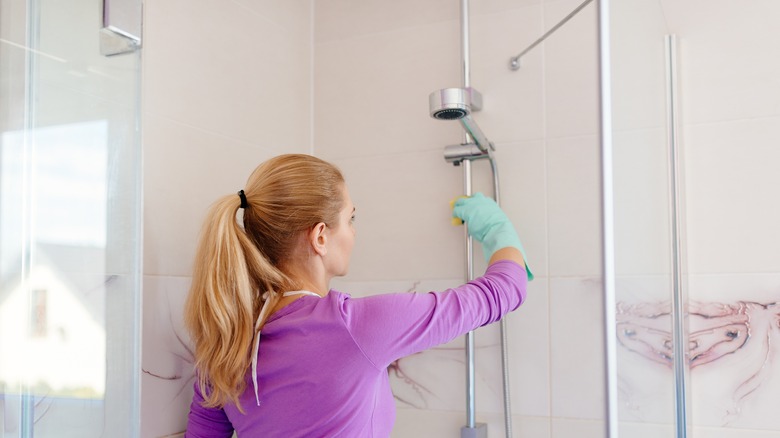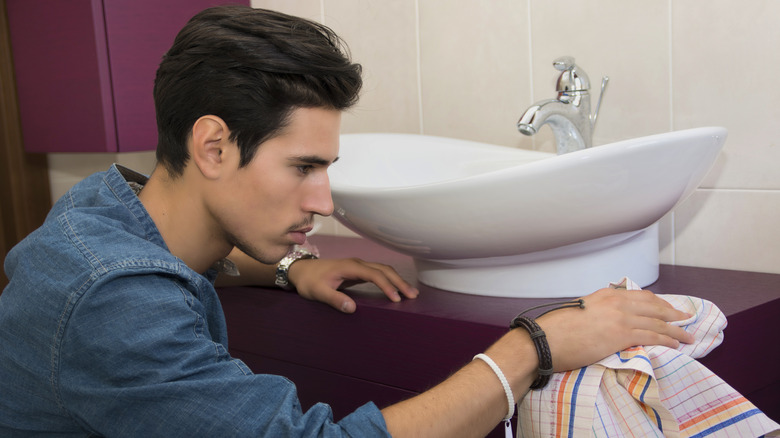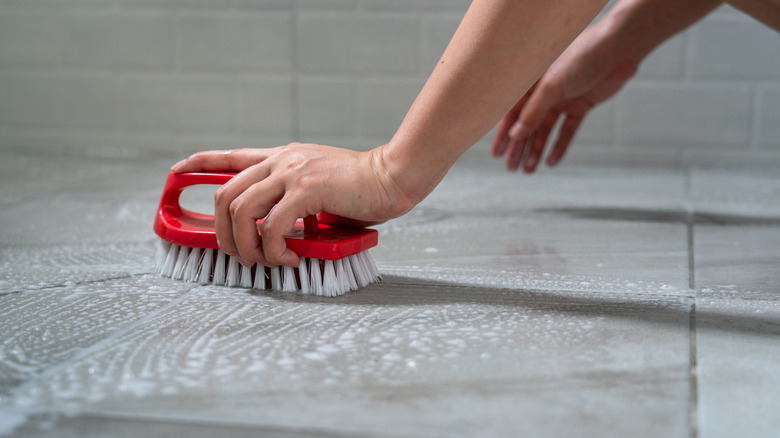The One Spot In Your Bathroom Experts Say You Should Clean First
Does it matter what you clean first in the bathroom as long as everything gets properly scrubbed down and sanitized? It can actually matter where you start with this chore. Cleaning the bathtub and shower is the best place to start before scrubbing the toilet or worrying about the fixtures. Why here? Why not the super dirty toilet or the dusty vent in the ceiling?
Alicia Sokolowski, the Co-CEO of AspenClean and an eco-cleaning professional, shares that the shower is the best place to start because it's generally relatively cleaner than other spaces in the bathroom. She notes, via Homes & Garden, "Do you associate the shower with always being clean? After all, the only thing you really use in the shower is soap and hot water." By starting with the least dirty surface in the bathroom and then working to the worst area, you're doing a better job of controlling the spread of germs.
If, on the other hand, you clean the toilet, easily the most grime-filled area in most bathrooms, that means you now have those germs on your towels and cleaning supplies, not to mention your hands. You don't want to inadvertently spread those germs to other areas of the bathroom. There are a few other things to keep in mind about cleaning the shower and tub.
Minimize cross-contamination throughout the cleaning process
As an eco-focused cleaning professional, Alicia Sokolowski also shares, "Vinegar and water or baking soda and water work for cleaning soap scum that builds up in baths, showers, and sinks." She recommends (via Homes & Gardens), "If you find those solutions aren't tough enough for those hard-to-clean areas, try mixing baking soda and vinegar to make a paste." This is a great way to start cleaning using the least harmful cleaning agents available. The shower, tub, and sink don't need the use of harsh chemicals in most cases. Most often, using these all-natural solutions will do a good job.
For those who hope to keep their bathrooms sparkling clean with the least amount of chemical use, avoid using chlorine bleach or other chemicals on surfaces where it's just not needed. However, other areas, like the toilet and floors, will benefit from the stronger chemicals. Focusing on the less dirty surfaces first means you don't have to worry about getting chemicals onto the sink area, helping to minimize the cross-contamination that can often happen otherwise.
Work through the rest of the bathroom, least dirty to dirty
Now that you have cleaned the bathtub, shower, and sink, work around the rest of the space tackling the least dirty areas first. Leave the hard jobs last. That means cleaning all surfaces in this space, including the shelves, walls, shower curtain, towel bars, and even the baseboards. After doing all of this, work on the floors and toilets. Use different cleaning cloths for both areas since you don't want to spread the majority of germs on either of these surfaces.
When cleaning the toilet, clean the outside and top of the tank first, then the bowl, and then the toilet seat. This way, you are getting the best level of cleaning, tackling the most likely dirtiest area last. Don't forget to clean the toilet brush, too. After the toilet, remove anything from the bathroom that's dirty and work on the floors. You may need to make a paste of baking soda and vinegar to get into the grout areas, and sometimes these need harsh chemicals to really come clean. Work from the cleanest area of the bathroom, such as by the door or sink, towards the toilet. Then, be sure to wash your hands before leaving this room of the home.


